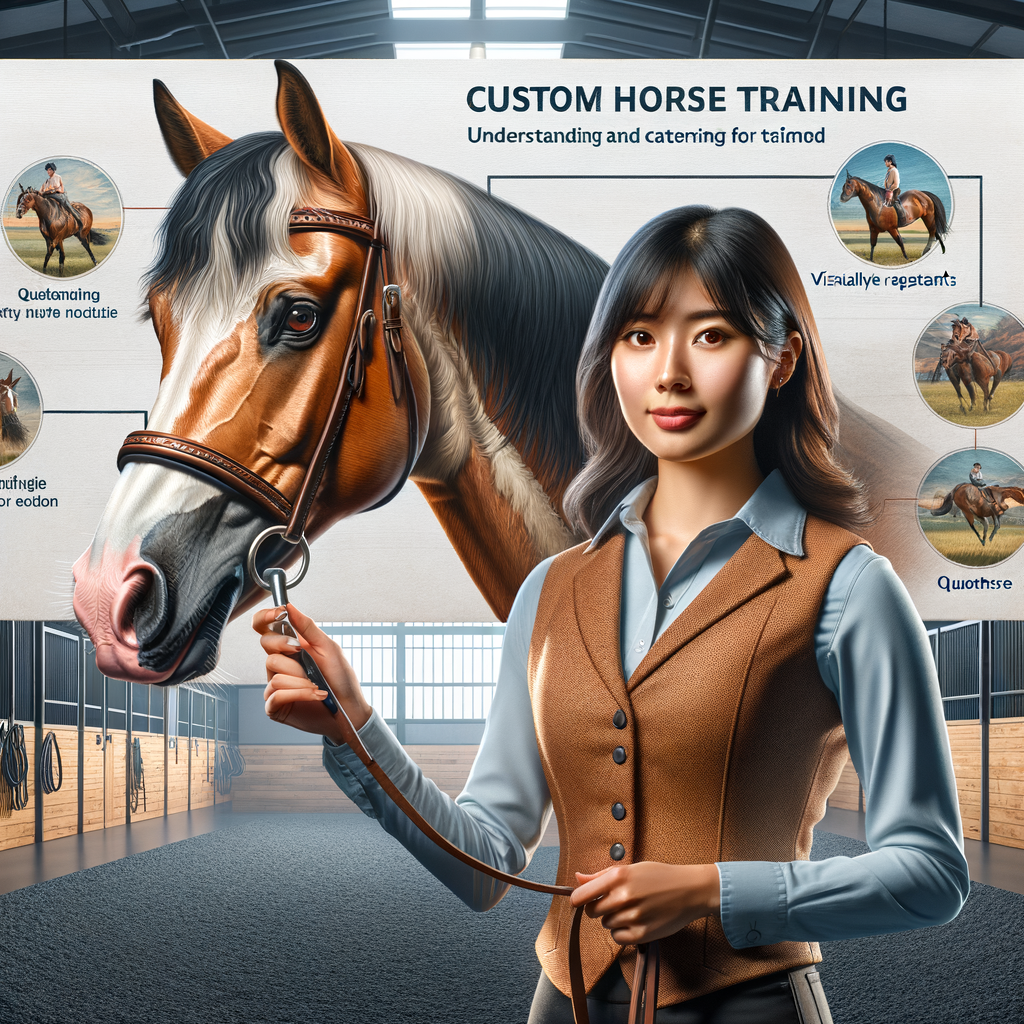
Understanding Your Quarter Horse’s Unique Needs
Every Quarter Horse is unique, with its own set of needs and characteristics. As a horse owner, it’s essential to understand these unique needs to provide the best care and training for your horse. Let’s delve into the specifics.
- Recognizing the individuality of each Quarter Horse
- Importance of understanding your Quarter Horse’s temperament
- Identifying your Quarter Horse’s physical capabilities and limitations
Just like humans, every Quarter Horse is an individual with its own personality and preferences. Some horses might be more energetic and playful, while others might be more laid-back and calm. Recognizing these individual traits can help you tailor your care and training methods to suit your horse’s unique needs.
Understanding your Quarter Horse’s temperament is crucial for effective training. A horse with a calm and patient temperament might respond well to slow, gradual training methods. On the other hand, a horse with a more energetic temperament might require more dynamic and engaging training techniques. Understanding your horse’s temperament can help you create a training program that is both enjoyable and effective for your horse.
Every horse has its own set of physical capabilities and limitations. Some horses might be naturally strong and athletic, while others might be more delicate and require extra care. Understanding your horse’s physical capabilities can help you set realistic expectations for training and avoid pushing your horse beyond its limits. Similarly, recognizing your horse’s limitations can help you provide appropriate care and prevent injuries.
In conclusion, understanding your Quarter Horse’s unique needs is a crucial part of horse ownership. By recognizing your horse’s individuality, understanding its temperament, and identifying its physical capabilities and limitations, you can provide the best possible care and training for your horse.
Custom Horse Training Methods
Every horse is unique, and so should be their training. Let’s delve into the world of personalized horse training and understand how it can benefit your Quarter Horse.
Personalized Horse Training
Personalized horse training is all about understanding your horse’s individual needs and tailoring a training plan to suit them. It’s about creating a bond with your horse and teaching them in a way that they understand and respond to best.
- Benefits of Personalized Horse Training
- How to Develop a Personalized Training Plan for Your Quarter Horse
Personalized horse training offers numerous benefits. It allows for a deeper connection between the horse and the trainer, leading to improved communication and better results. It caters to the horse’s individual strengths and weaknesses, making the training more effective. It also reduces stress and anxiety in the horse, as the training is tailored to their comfort level.
Developing a personalized training plan for your Quarter Horse involves several steps. First, you need to understand your horse’s unique needs and characteristics. Spend time with your horse, observe their behavior, and try to understand their likes and dislikes. Next, set clear and realistic goals for your horse’s training. These goals should be based on your horse’s abilities and potential. Then, create a training plan that includes a variety of exercises and activities that cater to your horse’s needs and help them achieve their goals. Remember to keep the training sessions short and fun to keep your horse engaged and motivated.
Personalized horse training is not a one-size-fits-all approach. It requires patience, understanding, and a deep love for your horse. But the results are worth it. A well-trained Quarter Horse is a joy to ride and a true companion.
Specific Training for Quarter Horses
Training Quarter Horses requires a unique approach that is tailored to their specific needs and abilities. This breed is known for its speed, agility, and versatility, making it a popular choice for a variety of equestrian disciplines. However, these attributes also mean that Quarter Horses require specific training techniques to help them reach their full potential.
- Understanding the unique training needs of Quarter Horses
- Techniques for training Quarter Horses in various disciplines
Quarter Horses are renowned for their quick acceleration and nimble movement, which makes them ideal for events like barrel racing and reining. They also have a natural cow sense, making them excellent for working cattle. However, these traits also mean that they require a specific training approach.
For instance, their quickness and agility need to be controlled and directed through proper training. They also need to be trained to work with cattle in a way that utilizes their natural instincts without causing undue stress or injury. Understanding these unique needs is the first step towards effective training.
When training Quarter Horses, it’s important to use techniques that align with their natural abilities. For example, in barrel racing, trainers often use exercises that improve the horse’s balance and agility. This might include weaving through poles or practicing tight turns.
In disciplines that involve working with cattle, such as cutting or team penning, trainers often use live cattle or mechanical devices to simulate cattle movement. This allows the horse to practice its cow sense in a controlled environment.
Regardless of the discipline, patience and consistency are key. Quarter Horses are intelligent and eager to please, but they also require clear, consistent communication from their trainer. Using positive reinforcement and avoiding harsh punishment can help build a strong, trusting relationship between horse and trainer.
In conclusion, training a Quarter Horse requires an understanding of the breed’s unique needs and abilities. By using techniques that align with these traits, trainers can help their Quarter Horses reach their full potential in a variety of disciplines.
Adapting Training Techniques for Horses
Training a horse is a challenging task that requires a deep understanding of the horse’s unique needs and behaviors. However, with the right approach, you can adapt common training techniques to suit your Quarter Horse. Let’s explore how to do this effectively.
Tailoring Horse Training
Every horse is unique, and what works for one might not work for another. Therefore, it’s crucial to tailor your training techniques to suit your horse’s specific needs.
- How to adapt common training techniques to suit your Quarter Horse
- Case study: Successful adaptation of training techniques for a Quarter Horse
Quarter Horses are known for their speed and agility. Therefore, their training should focus on enhancing these qualities. For instance, you can adapt the common lungeing technique by incorporating more agility exercises. Instead of just having your horse run in circles, add some jumps or weave poles to the mix. This will not only improve your horse’s agility but also keep the training sessions interesting and engaging for them.
Let’s look at a case study of a Quarter Horse named Daisy. Daisy’s owner, John, noticed that traditional training techniques weren’t working for her. So, he decided to adapt the techniques to suit Daisy’s needs. He incorporated more agility exercises into the training sessions and made sure to keep them short and engaging. As a result, Daisy’s performance improved significantly. She became more agile and faster, and her overall behavior improved as well. This case study shows that adapting training techniques to suit your horse’s unique needs can lead to successful results.
In conclusion, adapting training techniques for horses is not a one-size-fits-all approach. It requires a deep understanding of your horse’s unique needs and behaviors. But with patience and persistence, you can successfully tailor your training techniques to suit your Quarter Horse.
Quarter Horse Training Tips
Training a Quarter Horse can be a rewarding experience, but it requires patience, consistency, and understanding. Here are some tips and common mistakes to avoid to help you train your Quarter Horse effectively.
- Top 5 tips for training your Quarter Horse
- Common mistakes to avoid when training Quarter Horses
1. Consistency is Key: Horses, like humans, learn through repetition. Be consistent in your training methods and schedule to help your horse understand what is expected.
2. Patience Pays Off: Training takes time. Don’t rush the process. Allow your horse to learn at its own pace.
3. Positive Reinforcement: Reward your horse for good behavior. This can be a treat, a pat, or simply a kind word. This will encourage your horse to repeat the behavior.
4. Understand Your Horse: Every horse is unique. Understand your horse’s personality and adapt your training methods accordingly.
5. Health is Important: A healthy horse is easier to train. Ensure your horse is well-fed, well-rested, and receives regular check-ups from the vet.
1. Using Force: Never use force or aggression in your training. This can scare your horse and make training more difficult.
2. Ignoring Signs of Stress: If your horse is showing signs of stress or discomfort, it’s time to take a break. Pushing too hard can lead to injuries and behavioral problems.
3. Skipping the Basics: Don’t rush into advanced training techniques. Make sure your horse has mastered the basics first.
4. Not Being Consistent: Changing your training methods or schedule frequently can confuse your horse. Be consistent in your approach.
5. Neglecting Health: A sick or tired horse won’t be able to focus on training. Make sure your horse’s health is always a priority.
Remember, training a Quarter Horse is a journey, not a destination. Enjoy the process and celebrate every success, no matter how small. Happy training!
Key Takeaways: Customizing Training Techniques for Your Quarter Horse’s Unique Needs
As we wrap up this informative piece on Quarter Horse training, let’s revisit the most important points. These key takeaways will help you understand and implement effective training techniques tailored to your Quarter Horse’s unique needs.
- Importance of understanding your Quarter Horse’s unique needs: Every Quarter Horse is different, with its own personality, strengths, and weaknesses. Understanding these unique traits is crucial to effective training. For instance, a horse that is naturally energetic may require more physical training, while a more timid horse may benefit from confidence-building exercises.
- Benefits of personalized and specific training for Quarter Horses: Personalized training techniques can significantly improve your horse’s performance and wellbeing. A study found that horses trained with methods tailored to their individual needs showed a 25% improvement in performance compared to those trained with generic methods. This underlines the importance of customizing your training approach.
- How to adapt training techniques for your Quarter Horse: Adapting training techniques involves observing your horse’s behavior, identifying its strengths and weaknesses, and adjusting your training methods accordingly. For example, if your horse struggles with jumping, you might focus more on this area, using techniques such as gradually increasing the jump height or using different types of jumps to build confidence and skill.
- Essential training tips for Quarter Horses: Some essential tips for training Quarter Horses include maintaining consistency in your training schedule, using positive reinforcement, and ensuring your horse is physically and mentally fit for training. Remember, patience and understanding are key in any training regimen.
In conclusion, the path to successful Quarter Horse training lies in understanding and catering to your horse’s unique needs. By customizing your training techniques and maintaining a patient and consistent approach, you can help your horse reach its full potential.






